
by DharamCW | Sep 26, 2024 | Leadership in Project Management
Project management is becoming an essential component of modern business operations. Organizations increasingly use project management to monitor and assess projects and ensure they meet their objectives. Project management entails several complex processes, including project planning, organization, management, control, budgeting, monitoring, testing, and implementation.

Vance Packard Quote
Project leadership is the art and science of guiding a team to successful project completion. When project leadership brings people together to work toward a similar objective, the team can do more than they could individually.
Project Management Leadership
Leadership in project management is a necessary ability for completing the project. Like in other business areas, leadership necessitates demonstrating several talents and behaviors in a project context. Leadership is essential to ensure the success of the projects, from team leadership to project governance.
Leadership and project management are closely intertwined. Setting the vision and encouraging the team to work together to accomplish the project goal are vital components of leadership. In a project environment, this is particularly significant. Delivering any project requires a team effort. While some teams work without a clear leader, in business, it is customary for someone to be in the leadership role, guiding and directing the team toward their goals. On the other hand, project management systematically applies processes, methods, knowledge, skills, and experience to achieve the project objectives. Effective project management often requires strong leadership to guide the team through the project’s complexities and challenges.
5 Essential Project Leadership Skills
Project managers execute allocated project tasks through their project teams. They learn the technical, business, and leadership skills to manage their project teams effectively. In addition, they use strong leadership skills to motivate their teams to complete project deliverables and achieve project goals.
Project managers’ essential leadership skills begin with encouraging and inspiring their teams. However, the five critical project leadership skills are equally vital in enhancing team performance.
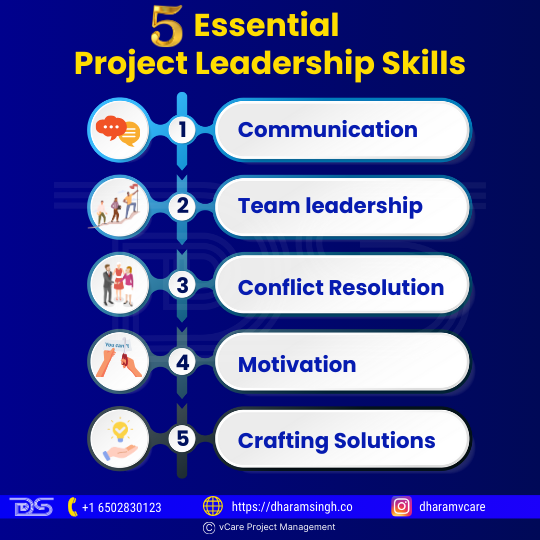
5 Essential Project Leadership Skills
- Communication
One of the most important project management skills is communication. Leaders must communicate effectively because a significant portion of their work includes collaboration. If you can communicate, you can collaborate properly.
Leaders can communicate ideas to people and groups in person, over the phone, or via web conferencing. They can also present their ideas to ensure the message is shared and understood. However, communication is more than just passing on messages and conversing with people. Communication is one of the most important characteristics of a project manager, especially in a leadership role.
- Team leadership
The leader establishes the vision and motivates others. Someone with outstanding project leadership skills fosters team agreement and togetherness while managing day-to-day operations.
Team leadership on projects entails establishing an environment in which everyone may thrive. People are lured to the project culture that surrounds them. Stakeholders want to be part of the project because they know you will complete the task while creating a pleasant working environment.
- Conflict resolution
Conflict is unavoidable when introducing or modifying something. However, effective leaders understand how to use conflict to their advantage since the finest solutions emerge when ideas are challenged.
Conflict may benefit teams by allowing all voices to be heard and opposing viewpoints to be expressed, frequently resulting in a better solution and more successful project outcomes. However, leaders must be equipped with conflict resolution skills to recognize and address conflict before it becomes a problem for the team. Therefore, another crucial core competency of project management is dealing with conflict in various ways.
- Motivation
Leaders motivate others to act even when they are not technically in charge. As a project manager, one determines what makes the other team members feel they’re giving their best. The project leader should do their best to deliver this. Everyone is driven differently, and motivation changes over time. Great leaders see these disparities and establish a great work environment to enable their workers to achieve their full potential.
- Crafting solutions
Empowering the team and the larger stakeholder community to participate in developing solutions is part of fostering a positive working culture. That entails removing roadblocks so that each team member may fulfill their work and contribute new ideas without concern about something getting in the way.
Empowering leaders also allows them to make decisions down the hierarchy to the lowest feasible level, allowing specialists to judge the solutions required to keep the project going. This empowerment fosters a positive working culture and inspires team members to take ownership of their work and contribute to the project’s success.
Leadership Styles and Theories
There is no single style to leadership, nor is there a particular type of person who makes a great leader. Instead, according to project leadership theory, a great leader is a mix of traits and the capacity to adapt to diverse conditions. This adaptability reassures individuals that leadership is not a fixed trait but a skill that can be developed and enhanced.
Leadership is something one can learn, and one can enhance one’s talents by understanding leadership theories in management. The three basic leadership theory categories that apply to project delivery are:
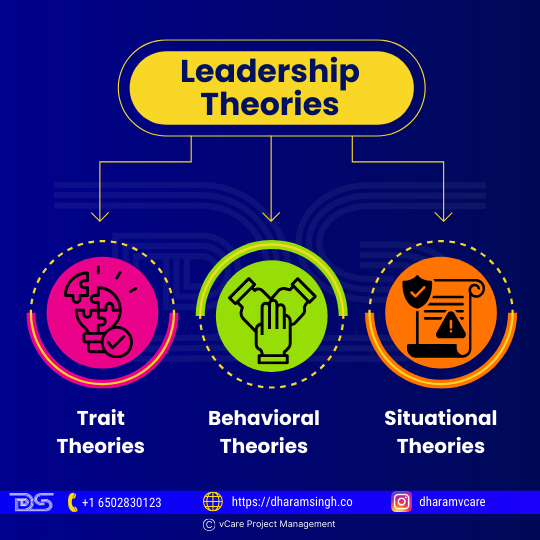
Leadership Theories
- Trait theories
Project manager strengths are related to trait theories. This perspective on leadership identifies the abilities and attributes that are beneficial while leading a team. Resilience, honesty, trustworthiness, aggressiveness, and so on are examples.
There was a system of thinking that stated certain characteristics were innate and that you were either born with them or not. Fortunately, this notion is no longer present in leadership concepts and theories. We know that an individual can act to become more aggressive and resilient or develop any other leadership trait.
- Behavioral theories
Behavioral leadership theories concern what a leader does. For example, some Corporate leaders are dictatorial and make decisions without consulting their employees. Others are more collaborative, inviting feedback and empowering their employees.
Both strategies are acceptable, and any combination of the two. However, there is a time and place for every style: you wouldn’t expect a combat leader to order a huddle so the team could discuss possibilities, would you? In that case, a choice must be taken immediately. Thus, a collaborative, listening leadership style would better engage the community.
- Situational theories
Situational leadership is deciding which leadership style to employ in any given scenario. These leadership theories are often known as contingency theories.
They analyze whether using a task-based or a people-based approach is more effective. They also take into account the individuals you lead. What type of encouragement and support do they require? A leader tailors their leadership style to the demands of the team, the business environment, and project circumstances. Someone who has never done specific work before will require more hands-on assistance from their team leader than someone confident in completing that activity.
Project Management Leadership Styles
Leadership in project management is essential for success. A project is a substantial and necessary endeavor in any business organization that requires full concentration and dedication from all participants. The success or failure of any business project can influence the company’s path. Project management is a critical role that may be entrusted to anybody, especially in today’s technology-driven business environment, where change is inescapable.
The ultimate success of every project is determined by project leaders, who have the authority to manage and oversee all project activities and make critical project choices. Similarly, failure to accomplish project objectives is the responsibility of the project’s leaders or management. Failure or inability to use the authority conferred upon them to ensure the project’s success is regarded as a point of accountability.
It is important to note that any project a firm does should strive to achieve certain goals that will enhance business operations and increase profitability, performance, output, and overall success in its objectives. As a result, project management is a critical function that leaders and anybody charged with project leadership must take seriously and utilize their effective leadership skills to ensure success.
Here are the six important project management leadership styles.

Project Management Leadership Styles
- Affiliative Leadership
This leadership style has a positive impact on a project team. This leader aims to create emotional bonds inside the organization to generate a sense of belonging and connection. When teammates require personal assistance or the team has to rebuild trust, the affiliative strategy is most successful. Because a single focus on praising and nurturing may result in poor performance and a lack of direction, this strategy should be used in various ways.
- Authoritative Leadership
Authoritarian leaders generate an entrepreneurial spirit and a strong devotion to the cause. Moreover, the traditional method works effectively when the team needs a new vision owing to changing circumstances or when clear guidance is unnecessary. Therefore, more utilization of this style would result in better project team outcomes without negative consequences, as this style has a generally positive effect throughout the organization.
- Coaching Leadership
This project management approach encourages team members to expand their capacity and capability as project contributors, which benefits the whole project team. This approach is the most effective coaching technique when a leader wants to assist colleagues in creating long-term personal characteristics that will help them succeed. However, it falls short when teammates are relentless about staying the same or learning or when the leader needs more aptitude.
- Coercive Leadership
Project managers rarely use this tactic, which would be more evident in times of crisis, such as when a project deadline was approaching and at risk of being missed.
- Democratic Leadership
This leader achieves successful compromises through teamwork. In a PMO, for example, each team member contributes to defining and measuring the PMO’s objectives. When the leader wants the team to buy into or own a decision, strategy, or goal, or when they are unsure and need new ideas from competent colleagues, the democratic method works well.
- Pacesetting Leadership
This leader anticipates self-management. The pacesetting approach works most effectively when the team is already motivated and talented and the leader demands quick results. This approach is popular, especially when a project nears major milestones. Although this method generally harms project teams, it can be beneficial in some situations.
Impact of Good Leadership on a Project
Many studies have highlighted leadership as one of the key reasons for project failure. On the other hand, projects with strong leadership and organizational support outperform those without.

Impact of Good Leaders on a Project
- Work moves forward quickly
When an individual actively leads, the work proceeds quickly as the choices are made on time. This move allows the project to be completed on schedule while delivering all planned project scope elements.
- The project has a clear direction
A leader ensures that the team knows and supports a common goal. A clear direction gives context for decision-making and ensures that everyone knows what the project will deliver.
- Conflict is resolved quickly
The project leader is constantly looking for conflict and can intervene to handle it before it escalates into a crisis.
- Interpersonal Skills
Project leaders must have interpersonal skills such as questioning, listening, and speaking to establish successful and compelling interactions with team members.
Experts in project management believe that projects are more likely to fail if project managers lack excellent interpersonal skills. Because much of a project manager’s duties involve communicating with stakeholders, one must have great interpersonal skills to lead from the front.
- Creating Excitement and Maintaining a Positive Attitude
The most crucial project manager leadership skills are boosting team members’ enthusiasm and displaying an optimistic attitude, especially in times of crisis. In addition, project management and leadership are about instilling trust in teams that there will always be a solution, no matter how serious a situation is.
- Honesty
When defining ethical guidelines and supporting transparency in communication, project manager leadership skills should embrace honesty.
Honesty and integrity are two fundamental traits of project management leadership that project managers should cultivate to increase trust among customers, members, management, and other stakeholders.
- Decision-Making
The project manager has the last say in simplifying processes and solving difficulties. As a result, the project manager’s capacity to make informed judgments is a critical function of leadership in project management.
Decision-making is an important project manager leadership skill that directly influences project outcomes. Therefore, to advance in their careers, all prospective project management professionals must master decision-making abilities.
Leadership mindsets are driving the new economy
Mindsets are mental maps that reflect and govern how individuals act in organizations. They convey how individuals work and what they stand for. So, what leadership characteristics do respondents and experts believe are necessary for success in the digital economy? World Economic Forum survey data states four leadership mindsets driving the new economy: producers, investors, connectors, and explorers.
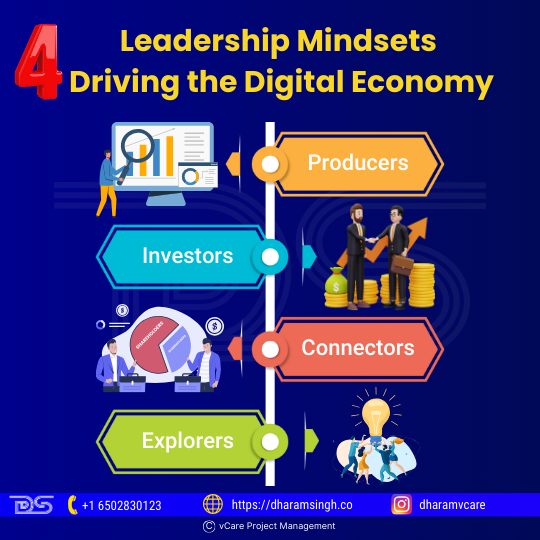
Leadership Mindsets Driving the Digital Economy
- Producers
The producers’ mindset blends with creating consumer value, emphasizing analytics, digital savvy, execution, and outcomes. Producers use analytics to expedite innovation that addresses shifts in customer preferences and enhances customer and user experiences.
- Investors
Leaders with an investor mindset seek a purpose for their firm beyond improving shareholder returns. They are committed to growth but in a sustainable way. They are concerned about the areas in which they operate, their personnel’s welfare, and ongoing development. They focus on increasing the value of their clients rather than treating them as money sources.
- Connectors
Leaders with a connector’s mindset see that mastering connections and networks is the new currency driving corporate performance in the new economy. Connectors understand this fundamentally. It’s how they work. They constantly bring various stakeholders from within the organization and ecosystem partners together. Connectors recognize the importance of building a feeling of community and belonging, which is especially vital in today’s fast-paced, breakneck-speed world when losing contact with the human touch is too easy.
- Explorers
Leaders with an explorer’s mindset are curious and innovative and thrive on ambiguity. They constantly experiment and learn by listening to a wide range of voices. Establishing behavioral standards encouraging risk-taking and failure, reverse mentorship, and a deep curiosity about how new forces shape the competitive environment are strong indicators of an explorer’s attitude.
Final Thoughts
Project management is a demanding task requiring effective leadership styles and traits for the project’s overall success. Successful project leadership involves team building, adaptability, communication, and effective planning skills. As a result, leaders play a fundamental and crucial role in project management since their approach decides whether a project will succeed or fail.
Project management is different from leadership. Successful project managers may need to be more effective leaders. However, they can learn leadership qualities and become successful leaders. In today’s firms, competent project managers must also be strong leaders. Successful project managers may use their innovative and creative capabilities to assist them in acquiring leadership skills that will complement their project management abilities by recognizing the difference between project management and leadership and adopting the road to becoming influential leaders.
The common component of project management and leadership is the standard by which the project manager and leader’s performance is judged. A project manager’s success and a leader’s effectiveness are evaluated in terms of the performance of the followers—the team’s performance. As a result, improving project managers’ leadership skills with an emphasis on abilities to increase team performance should be a key factor.
Leadership is critical in project management and must be balanced. It impacts project success and the value offered to the organization. The good news is that the finest project management training incorporates leadership concepts, providing employees with a well-rounded understanding of what it takes to lead a project.
With advanced certifications like PMP®, Agile, PgMP®, and PfMP® certifications, one can develop project management skills, be a good problem solver, be a more competitive candidate for positions, and be a successful project leader. In today’s competitive business world, one must be skilled and experienced to succeed and grow their career.
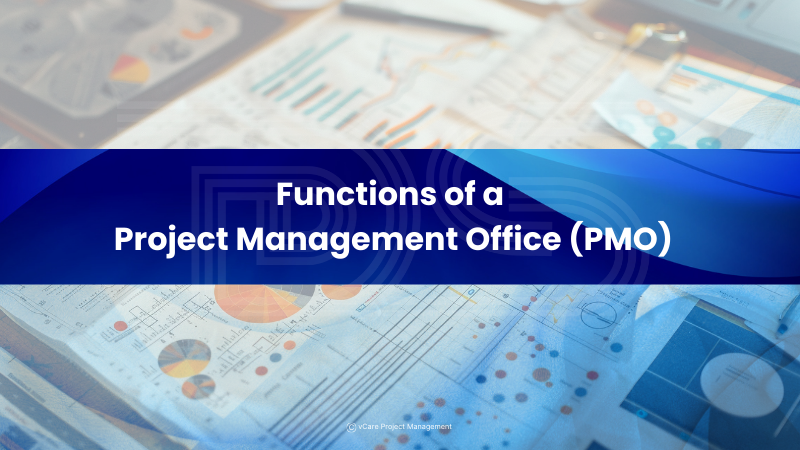
by DharamCW | Aug 5, 2024 | Leadership in Project Management, Project-Program-Portfolio Management Knowledge
Functions of a Project Management Office (PMO)
In the dynamic world of project management, the Project Management Office (PMO) is a cornerstone for driving success and strategic alignment. Here’s how a mature PMO can transform your organization:
1. Governance: Ensure informed decision-making with structured audits, peer reviews, and robust project and program frameworks.
2. Transparency: Provide stakeholders with accurate, relevant information for effective decision-making.
3. Reusability: Promote knowledge sharing to prevent duplicated efforts and leverage a central repository for lessons learned, templates, and best practices.
4. Delivery Support: Minimize bureaucracy while offering essential training, coaching, mentoring, and quality assurance to project teams.
5. Traceability: Maintain comprehensive documentation, project history, and organizational knowledge.
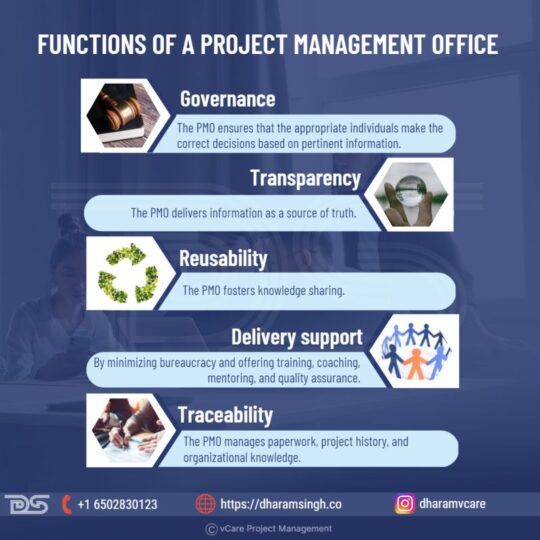
Unlock the full potential of a PMO—learn how governance, transparency, and support drive project success.
A well-structured PMO supports your projects and aligns them with your business strategy, ensuring optimal performance and success.
Stay ahead of the curve by understanding and implementing these PMO functions effectively. Join me in exploring the transformative power of PMOs to elevate your project management practices.
🚀 Elevate Your Project Management Career:
– Register for my upcoming PMI Certification Success Story Webinars: https://bit.ly/3QeVhKF / https://bit.ly/3Kg4waj
– Book an obligation-free consultation session on Project management Career, training, and certifications: http://talktodharam.com
– Discover training offers and certification discounts: https://bit.ly/3jWVepD
– Stay updated with our Q&A series and certification success stories by subscribing to the vCare Project Management YouTube channel at https://bit.ly/2YF0wJl
– Follow my podcasts and interviews with Project Management Experts on YouTube at https://bit.ly/2NDY8wd
#ProjectManagement #PMO #BusinessStrategy #ProjectManagementOffice #ProjectGovernance #Transparency #Reusability #DeliverySupport #ProgramFrameworks #Traceability #DecisionSupport #KnowledgeSharing #ProjectDelivery #AskDharam #DharamSingh #VCareProjectManagement #ProjectManagementBestPractices
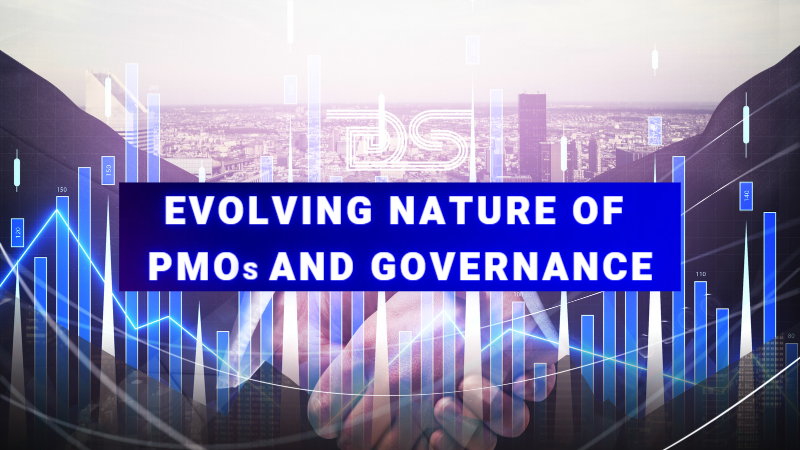
by DharamCW | Sep 8, 2023 | General
From a strategic standpoint, the PMO is critical in project management. Unlike project management, which focuses on the day-to-day operations of a project team, the PMO serves as a framework for project managers, offering PMO methodologies and templates for managing programs inside an organization. In addition, it manages the project management resources required to sustain and deliver projects.
Project management offices (PMOs) are evolving from purely administrative to strategic roles. They are rethinking PMO operations, adopting new technology, and implementing new project management operating models. The evolved PMO is a new PMO concept that is gaining traction. A creative, strategic, and adaptive PMO designed to help modern organizations deal with the volatility of today’s market conditions.

Functions Of A Project Management Office
Functions of a Project Management Office (PMO)
A project management office (PMO) is the foundation of a successful project management strategy in a business. It is a function that gives decision-support information but does not make choices.
A project management office (PMO) supports project delivery mechanisms by ensuring that all business change in a company is controlled. PMOs perform various duties, and their services depend on the department’s maturity and the PMO personnel’s talents. At its most basic, the PMO assists project management teams in making funding, prioritizing, and resource choices. The most mature PMOs provide the following:
1. Governance: The PMO ensures that the appropriate individuals make the correct decisions based on pertinent information. Audits or peer reviews, designing project and program frameworks, and maintaining accountability at all levels are all part of the governance role.
2. Transparency: The PMO delivers information as a source of truth. Information should be relevant and accurate to promote good decision-making and be presented to individuals understandably.
3. Reusability: The PMO fosters knowledge sharing. This aspect prevents project teams from reinventing the wheel and positions the PMO as the hub for lessons learned, templates, and best practices.
4. Delivery support: By minimizing bureaucracy and offering training, coaching, mentoring, and quality assurance, the PMO makes it easier for project teams to accomplish their duties.
5. Traceability: The PMO manages paperwork, project history, and organizational knowledge.
In reality, most PMOs will do various tasks and offer services tailored to the organization’s requirements.
How Business Agility Drives A Shift In Focus For Today’s PMOs
Forward-thinking companies are fast learning that “simply getting the job done” will not equip them for long-term company success. To be successful in business today, firms must provide products and services that satisfy their clients while constantly innovating to grow their markets.
Historically, PMOs were responsible for managing tactical operations that supported project development and implementation. Today’s Corporate leaders recognize that to stay ahead of the market; they need to exploit new possibilities while limiting unanticipated risks – this necessitates a new approach to planning, building, and delivery. Maintaining consistent levels of project success involves more than an organized strategy; it demands a company’s collective attitude to accept required disciplines while staying flexible enough to respond to changes in their business.
1. A major project fails — badly: When an expensive, strategic initiative fails in a competitive market, it compels a company to rethink its strategy. A third of the organizations polled cited a big failure as the impetus for shifting emphasis.
2. A project goes over budget: An underlying driver is cost reduction; project success at higher-than-expected costs decreases profitability and damages customer relationships.
3. A PMO aids a strategic project to succeed: Success, on the other hand, is a catalyst for change. Therefore, the following important reason for building a strategic PMO would be to capitalize on the momentum produced by the successful project.
4. Market competition forces stronger disciplines: Maintaining market share and growing at a controllable rate encouraged larger firms to create consistency to innovate. The capacity to pivot and explore possibilities prompted smaller businesses to establish a strategic PMO.
Key Factors to a Successful PMO Transformation
Established businesses and fast-growing firms are both adapting to changing business environments brought on by competition, acquisitions, developing technology, and new risks. As a result, the importance of alignment, built-in quality, transparency, and the capacity to execute across various project endeavors has never been greater. Innovative design thinking, continuous delivery, excellent quality, and a never-ending drive for improvement are some of the essential characteristics of a modern-day PMO. Here are some causes driving PMO evolution and the seven elements required to turn a typical PMO into a transformation management office (TMO).
Drivers behind the PMO Evolution
Due to increased external business environment constraints, businesses must achieve rapid and substantial value from their projects and initiatives. This aspect means shorter delivery cycles, the adoption of developing technologies, and regularly changed priorities for the PMO. To achieve this transition, the PMO must move its focus from project execution technique to value-driven business results. Change drivers are often aligned with three fundamental needs:

Drivers behind the PMO Evolution
1. Capacity and skills:
- Specific domain areas of technical expertise required
- Extra capacity required
2. Rapid Execution:
- Organizations require rapid execution to address immediate concerns
- No time to plan, but need to execute now to meet deadlines (e.g., regulatory compliance dates)
3. Innovation:
- Legacy project management no longer meets expectations
- Value focus, agility, quality, and continuous improvement are required

Transformation Management Office Critical Factors
Critical Factors to Consider
1. Leadership: TMO core values of alignment, built-in quality, transparency, and program execution must be completely embraced by leaders. They must adopt an agile mindset, emphasizing respect for people and culture, flow, innovation, and continuous development while cultivating a culture of trust and safety when setbacks occur.
2. Organizational Agility: Processes at the program and project levels must be improved to deliver value quickly while allowing companies to restructure and adapt to changing priorities.
3. Lean Portfolio Management: Goals for funding and execution must be aligned around workstreams that bring value to business priorities. Organizations may use this to optimize operations throughout their project portfolio. In addition, governance, monitoring, and decision-making for programs and projects should be decentralized to decrease overhead while boosting agility.
4. Enterprise Solution Delivery: The whole software development life cycle can be aligned with a DevOps methodology that refines and coordinates the work product across workstreams, supply chains, and suppliers to achieve and sustain continuous delivery.
5. Agile Product Delivery: Methods for delivering programs must begin with a customer focus and design thinking while aligning the continuous-delivery pipeline to a release cadence that provides optimum value to the customer.
6. Team and Technical Agility: Teams must be high-performing and cross-functional, with the knowledge and competence to design and execute high-quality solutions and work products aligned with customer-focused business goals.
7. Continuous-Learning Culture: Investing in being a learning organization is critical for employee transformation. Employees must be empowered to discover and uncover future value by embracing innovation and design thinking. Continuous improvement of solutions, processes, and products should be a priority at all levels of the business.
The evolving role of the PMO in digital transformation
Digital transformation has swept across organizations of all shapes and sizes to keep up with the growing expectations and needs of an increasingly digitized world. However, more people are learning that successful digital transformation entails transforming core cultures, structures, and techniques and integrating digital tools. Therefore, the function of the PMO in organizations must adapt to accommodate this shift as organizations evolve to accommodate this change.
According to a PWC study, 70% of organizations had or were working on a digital transformation strategy before the pandemic. Digital transformation may provide several benefits, ranging from better operational efficiency and product quality to increased customer satisfaction and lower development expenses.
However, PMOs have become linked with bureaucratic processes and unnecessary documentation. Their role must develop beyond the conventional limitations of “standards enforcers” to embrace their strategic role as change agents fully. Future PMOs must be at the forefront of emerging technology and implement various tactics that will allow the organization to make the most of available technologies.

Five ways the PMO drives digital transformation
Five ways the PMO drives digital transformation
1. PMOs can inspire and encourage change
The PMO’s role is to assist organizations in gaining the support of all key stakeholders for a digital transformation. Teams are more inclined to invest in digital projects if the transformation’s advantages are personal. PMOs may implement explicit feedback mechanisms to ensure that all important input is easily supplied, reviewed, and acted upon.
2. PMOs act as the strategic arm
PMOs must ensure that their digital transformation plan is consistent with the organization’s overall strategy. For example, investing in high-end software is pointless if your company is attempting to save money and merely needs essential project management tools. PMOs must also comprehend the strategic benefit of digital technology investments and be able to quantify, justify, and carry out plans.
3. PMOs provide support and insight
Digital transformation programs are frequently large-scale enterprise-wide undertakings that need ongoing support and higher-level knowledge to influence their development. For example, PMOs may assist employees via virtual portals with the help of a PPM solution while also gathering Big Data to help evaluate the new technologies’ success and efficiency.
4. PMOs properly manage transformations
Introducing new technology frequently entails forming new teams and learning new skills to ensure a successful adoption process. Managing digital transformation entails guaranteeing the availability of relevant resources, skills, feedback mechanisms, and data collection procedures. PMOs can monitor the full effect of digital transformation activities, manage possible bottlenecks or pressure spots, and optimize ongoing operations.
5. PMOs enable successful digital adoption
PMOs are essential in getting people excited about digital initiatives and driving further use of the tools or processes. PMOs may assist employees in understanding the value of digital technologies by delivering interactive demos and holding learning sessions. When more individuals utilize the application, there is more data to accurately analyze the overall performance of digital activities.
Project Governance and its components
Project governance is an oversight position that includes the project life cycle. It is tied to the governance model of the organization. It provides the project manager and team with structure, processes, decision-making models, and tools for effectively managing and controlling the project. Project governance is critical, especially for complex and risky enterprises. It defines, documents, and communicates consistent project processes to give a whole way of project control and success. It includes a framework for making project choices, defines roles, obligations, and liabilities for project completion, and controls the project manager’s performance.

Components of Project Governance
Components of Project Governance
According to PMI, eight project governance components offer real-world value:
1. Governance Models
The organization should develop a baseline of important aspects required for project governance based on the project’s scale, duration, complexity, risk, stakeholders, and relevance to the company.
2. Accountability and Responsibilities
The project manager’s primary responsibility is to define accountability and obligations. An organization’s operations will only be successful if accountability and obligations are adequately distributed. Therefore, the project manager must specify who is accountable, responsible, consulted, and alerted for each project’s deliverables.
3. Stakeholder Engagement
It is essential to thoroughly understand the project environment while setting the groundwork for your governance plan. The first stage is to identify all of the stakeholders. If even one stakeholder is excluded, it can disrupt the entire project and have a negative impact. One must identify stakeholders from various sources, including sponsors, suppliers, the project team, government boards, company owners, etc. The project manager must identify the stakeholders, their interests and prospects, and, most critically, how to interact with them.
4. Stakeholder Communication
The project manager must design a communication plan after identifying all stakeholders and describing their interests and expectations. A well-planned communication strategy provides all stakeholders with concise, efficient, and timely information.
5. Meeting and Reporting
Once the communication strategy has been properly designed, the project manager ensures that the optimal mix of meetings and reporting is in place. It is critical to design the communication strategy so that each stakeholder knows the mode and content of the communication and the owner, receiver, communication milestones, and decision gates. Furthermore, communication must be concise, accurate, and to the point.
6. Risk and Issue Management
Projects and programs are riddled with hazards and difficulties due to their uncertainty and unpredictability. It is challenging to forecast what will happen. Still, it is vital since a lack of preparation will throw the project team well behind schedule. Any project or program must begin with an agreement on identifying, categorizing, and prioritizing risks and concerns. How the danger or issue is handled is far more significant than the issue itself.
7. Assurance
Project assurance ensures that risks and concerns are addressed effectively and provides the indicators that provide delivery confidence. One of the most important aspects of assurance is developing metrics to provide a view of project success.
8. Project Management Control Process
It is the simplest component yet the most complicated to implement. Process control activities, metrics relevant to the project, and measurements are monitored and controlled. Also, this is a collaborative review; the management must monitor performance regularly and address any variances on time.
Creating project governance is more complex than it sounds. First, a significant investment is required when embarking on a new project. What’s more challenging is determining what advantages are linked with it. The following are four major advantages of project governance:
- Single point of contact
- Problem management and resolution
- Information dissemination and clear communication
- Outlines the roles, connections, and responsibilities of project stakeholders
Reinvent the PMO’s role in the digital age
The structure, provenance, and stakeholders of IT strategy, regulation, and management operations are changing dramatically due to digitization. As a result, the project management office, or PMO, must move its focus from project governance and delivery to digital transformation. According to a Gartner study, 87% of firms prioritize digitalization. Furthermore, today, 77% of an executive’s top priorities depend on technology.
As a result, PMOs are under enormous pressure to transform. But unfortunately, the project, program, and portfolio management processes they build and monitor are geared toward predictability and consistency rather than the speed and flexibility necessary to satisfy digital demand.
More flexible job descriptions and growing ownership of project management activities by business partners and other delivery professionals put traditional hierarchies and established PMO positions to the challenge. As a result, the PMO’s future role in digitization initiatives is established rather than for it since it usually needs to be considered in discussions about digitally driven changes to the IT operating model.
The traditional role of the PMO: Three advantages
Organizations are altering the function of the PMO in response to better support the enterprise’s digital aspirations. To accomplish so, they must examine possible activities critically through the prism of the PMO’s comparative advantages. The majority of PMOs have three main benefits, which are either inherent because of the PMO’s function or location or were developed as a result of experience:
1. A neutral enterprise perspective:
As capital allocation and portfolio priority approaches alter to give the financial flexibility necessary for digital work, the PMO’s objective, enterprise-wide perspective on demand, investment, and resource consumption, is more valuable.
2. The ability to operate via influence:
As organizational boundaries grow more flexible and who “owns” project management becomes less definite, influencing and empowering others, rather than direct ownership, becomes even more crucial.
3. Stakeholder insight:
As digitalization expands throughout the business and accounts for an increasing quantity of work, the number of first-time stakeholders and stakeholder complexity for each work item increases. Therefore, understanding the preferences of these many stakeholders and experiencing synthesizing their feedback becomes critical in producing results from digital work.
The PMO’s new role: Advancing digital ambitions
Leading PMOs are leveraging these advantages to shift the focus of their mission away from governance and delivery activities, embracing a strategy-over-governance and management-over-operations stance. Here are three approaches to altering the PMO’s role in the digital age:

Altering the PMOs role in the Digital age
1. Orchestrating delivery and team workflows
The PMO is well-suited to develop and promote interactions across increasingly different types of work and stakeholders due to its enterprise perspective and stakeholder insight. PMOs can play significant roles in driving the adoption of new delivery practices (e.g., Agile, DevOps) and will need to build systems for team collaboration across methodologies. This move entails identifying and managing interdependencies that might derail existing activity and lowering the effort necessary for interaction across teams, other governance roles, and third parties.
2. Developing and enabling digital talent
PMOs have expanded their roles in creating and fostering digital talent, adjusting career paths, and equipping project management professionals with the skills and techniques required to handle increasingly dynamic digital work. This initiative includes fostering new competencies such as product ownership, cultivating an enlarged network of project management practitioners, and providing targeted assistance for increasing business-managed projects.
3. Supporting digital transformation
Digitization is driving change in the IT operating model, with 52% of IT businesses utilizing or planning to use a new model centered on product lines. The PMO’s role in facilitating this transformation will be essential in the future. For example, the PMO may assist with enterprise-level capital allocation, design, and management of product line investment roadmaps, assess product line success, and manage the organizational transformation required when IT transitions to product lines. Aside from IT, the PMO will be asked to help implement digital business activities.
Final Thoughts
The future PMO will be more strategic and intricate than traditional approaches, emphasizing driving decision-making, execution, and outcomes while becoming more decentralized to interact with each workstream to achieve one common goal efficiently. Finally, PMOs will be more crucial than ever in addressing the challenges that organizations are now confronting. An effective transformation will need PMOs to act as the organization’s voice and face.
As the pace of digitalization increases, the PMO role will be put under increased pressure. As a result, PMOs are looking for methods to cut back on their time and effort on operational and governance tasks. Thus, PMO leaders must leverage their unique assets to change their focus from governance and delivery assistance to strategy and management activities that support digital projects.
Feel free to check out my discussion on this topic with Justin Buckwalter in YouTube
For any questions related to your Project Management career, training, and certifications, you can book an obligation free 15 minutes session with me by visiting https://bit.ly/2SbhTOK
You can subscribe to the vCare Project Management YouTube Channel to catch future videos of our Q&A series and certification success stories: https://bit.ly/2YF0wJl
You can subscribe to and follow my podcasts and interviews with Project Management Experts on YouTube at https://bit.ly/2NDY8wd

by admin | Jun 4, 2023 | General
Project management may be challenging. Addressing changing business demands, allocating limited resources, and managing team workloads can all result in dealing with complicated project management aspects on a day-to-day basis. However, having high-level assistance and guidance can be a lifesaver. Steering committees accomplish precisely that. Project management steering committees give administrative assistance and troubleshoot issues to keep projects on schedule to achieve their objectives.

Steering Committee
Steering Committee
A steering committee is an advisory body of important stakeholders overseeing and supporting a project to ensure its success. Project steering committees are also known as stakeholder boards, senior leadership teams, and project working groups. They manage projects from beginning to end, offering direction and assistance throughout the project’s lifecycle.
A steering committee’s primary concern is the organization’s direction, scope, budget, timeline, and techniques. Steering committees will meet regularly to discuss these issues to identify where they are and where they want to go to stay on track.

Project Steering Committee
Project Steering Committee
A steering committee may also be a group working together on initiatives. In this case, steering committees assist project managers in ensuring that projects are aligned with business objectives. They identify and manage risks, maintain project quality, and track progress and timeframes. In addition, the committee can approve changes to the project scope, budget, and strategy.
A project steering committee is a part of a larger organization for project governance. Companies that plan major projects that need collaboration across departments and include multiple stakeholders gain from a steering committee that can direct project management. The committee supervises the team’s progress toward fulfilling benchmarks and goals in this role.
The committee is in charge of project management, financial analysis, and recognizing changes that influence the project’s original scope. Furthermore, the project steering committee ensures that all points of view are heard and that any problems between stakeholders or departments are resolved.
Role of a Steering Committee
A steering committee can accomplish its core goal by utilizing a range of group and individual functions. When a steering committee gives advice and guarantees that items are delivered on time and in good condition, a company may reap significant benefits from its project successes. Some of the most important group-based steering committee positions that influence a business’s and consumers’ satisfaction with a product include:
- Providing input on the growth or development of a business or initiative.
- Addressing concerns and offering guidance on budgeting, marketing, recruiting, and other financial issues.
- Identifying the outcomes or objectives that the project must achieve.
- Prioritize the steps and objectives that must be completed to meet the project’s objectives.
- Assisting in the formulation of business-related policies, processes, and guidelines.
- Identifying, monitoring, and eliminating potential operational risks.
- Setting project deadlines or timelines and keeping track of progress.
- Monitoring the final work’s quality.
- Making plans for how a client or consumer will react to a product or service.
- Analyzing and discussing changes that have occurred or will occur to guarantee the project’s success.
- In the workplace, encouraging team members to collaborate.
- Where relevant, providing further insights on business or project concerns.
Members of the steering committee generally do not work on the project directly; nevertheless, committee members may perform various tasks individually to help assure the project’s success. Therefore, individual steering committee members should understand and strive to improve the strategies used to achieve project goals, be genuinely interested in the project and its outcome, promote the project whenever possible, and maintain a broad understanding of project management concerns, in addition to attending team meetings.
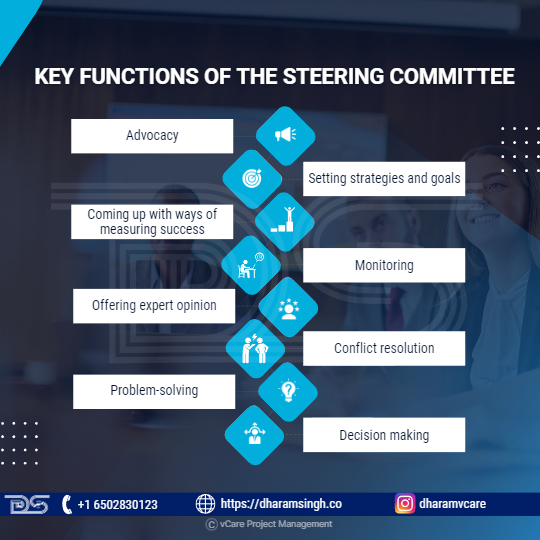
Key Functions of The Steering Committee
A steering committee is an advisory committee made up of various stakeholders and firm officials. They assist in making choices on various initiatives, with members directly interacting with project managers. Here are some of the key functions of the Steering Committee:
- Advocacy
A steering committee advocates for the organization’s varied goals and programs. Remember that it is generally composed of top management and specialists.
- Setting strategies and goals.
Steering committees develop strategic directions for initiatives. They also provide advice and opinions on budgeting, assets, money, time, facilities, marketing, and hiring. Goals and project scope are established as part of their employment.
- Coming up with ways of measuring success
There are several metrics for measuring performance. The steering committee is in charge of establishing how a product’s success is measured.
- Monitoring
The steering committee serves as an advisory body as well as a monitoring body. It ensures that projects fulfill the necessary quality standards and monitors any changes. It also keeps track of project processes and plans, which is critical to project success. The committee also analyzes and monitors project or company hazards before devising solutions to mitigate them.
- Offering expert opinion
The steering committee comprises experts who provide expert opinions on various issues concerning projects or the entire business. Their involvement is generally required, especially while working on a complex project.
- Conflict resolution
Disagreements are normal, mainly while working on a specific project. However, to ensure that issues do not disrupt the overall project, these committees resolve disputes between stakeholders, giving them more time to focus on what is best.
- Problem-solving
One of the functions of any advisory body is to discover solutions to problems the organization may be experiencing. It can generate various problem-solving ideas due to the experts on the strategy committee.
- Decision making
Although the steering committee’s primary function is to provide counsel, it also participates in decision-making. For example, it can analyze, accept, or reject project plans or recommend revisions to the supplied plans based on the members’ feedback.
The committee also engages in role allocation because its members can appoint project managers and other professionals to complete assigned tasks.
Ways to prepare for the project steering committee meeting
Important information and documents must be communicated with all steering committee members before the planned meeting, including:
- Meeting agenda
- Minutes of the previous steering committee meeting
- Project progress report from the project manager
Certain team members should be in charge of creating steering committee meeting documents and scheduling meetings. The steering committee is led by a chairperson who runs the meeting according to the agenda. They also ensure that all committee members express their viewpoints and ideas.
A basic meeting agenda would include the following:
- Recognizing and distributing the previous steering committee meeting minutes with other committee members.
- Conduct a thorough review of action items decided at previous sessions.
- Analyze the project status report filed by the project manager.
- Have a thorough discussion about any additional issues of concern or project requests.
- Select a date, time, and location for the next steering committee meeting.

Steering committee Best Practices For Project Success
Steering committee best practices for project success
Consider the following steering committee best practices for project success, whether you hold your meeting online or in person:
- Allow adequate time for the project team and committee members to prepare.
- Focus on the most important project KPIs and milestones and deliver them to the committee members in a format that everyone can agree on, such as a presentation, report, or infographic.
- Present project facts that are factual, contextual, and relevant. Share any inconsistencies or difficulties as soon as possible before they become significant issues.
- Schedule meetings in advance and automate meeting alerts to go out a week and a day ahead.
- Ensure comprehensive documentation of all meeting discussions and distribute it to committee members before the next meeting.
- Maintain the project charter and refer to it whenever there is doubt about authority, accountability, or strategic direction.

Challenges for Steering Committees
Challenges for Steering Committees
Because project management steering committees are comprised of employees from various backgrounds and functions, they will almost always experience certain challenges. These are some examples:
- Conflicting interests:As the committee includes cross-functional representatives, they will frequently have opposing ideas and interests. People think differently, which may be shown in their behavior, activities, and perspectives.
- Slow decision-making:Team decision-making is typically slower than individual decision-making.
- Lack of clarity in roles:Many committee members may need to know their individual or team responsibilities. A clearly defined charter for the steering committee ensures transparency and clarity about their duties in the project.
Final Thoughts
Every organization needs a Project Steering Committee to lead its transformation initiatives, beginning with a contemporary approach to project management. It may be instantly productive by initiating the process of managing project priorities. Steering committees are extremely crucial in efficient project management. They add value by keeping projects on pace, reducing risks, and resolving problems. When creating one, it is essential to evaluate the overall composition.
The steering committee plays a crucial role in project management that should be considered. The steering committee is the project’s administrator. This functionality does not exonerate the project of responsibility. On the contrary, this role necessitates that the steering committee participates in the project and not simply monitors the project group’s performance from the sidelines. This move will strain the steering committee’s multiple tasks and the time spent on the project.
Feel free to check out my discussion on this topic with Justin Buckwalter in YouTube
For any questions related to your Project Management career, training, and certifications, you can book an obligation free 15 minutes session with me by visiting talktodharam.com
You can subscribe to the vCare Project Management YouTube Channel to catch future videos of our Q&A series and certification success stories: https://bit.ly/2YF0wJl
You can subscribe to and follow my podcasts and interviews with Project Management Experts on YouTube at https://bit.ly/2NDY8wd

























Recent Comments